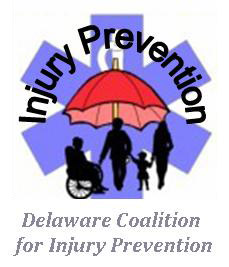Delaware Coalition for Injury Prevention

| Home | Data | Resources | Activities Calendar |
PREVENTION TEAMS:
| – Dog Bites | – Drowning/Submersion Injuries | – Falls |
| – Fires/Burns | – Motor Vehicle Crashes | – Poisoning |
| – Traumatic Brain/Spinal Cord Injury | – Violent Injury |
Prevention of Drowning and Submersion Injuries Team

What’s the Issue? Does Drowning Really Happen?
- Anywhere there is water, a drowning can occur—including in bathtubs, swimming pools, wading pools, and buckets.
- Drowning is the 5th leading cause of accidental injury death in the United States.
- Approximately 10 unintended drowning deaths occur each day; that’s 3,650 drowning deaths every year. 2 out of every 10 unintentional drownings involve children under the age of 14 years.
- Drowning is the leading cause of injury-related death among children between 1 and 4 years old. Recent research has shown that minority children are more likely to drown than non-minorities.
- Nearly 80% of drowning victims are male.
Source: CDC, 2012
What are Risk Factors for Drowning?
- Lack of safety barriers – when used properly, safety barriers such as fencing and locked gates can restrict access to aquatic areas.
- Insufficient supervision – young children must be closely supervised when near water to ensure safety. Choosing to swim without a lifeguard on duty is another risk.
- Mental impairment due to drugs or alcohol – these can affect one’s ability to recognize and respond appropriately to a potentially dangerous situation.
- Seizure disorders – drowning is the most common cause of unintentional injury death for those individuals with seizure disorders.
- Swimming ability – learning how to swim is important step toward avoiding a water injury.
- Not using a life jacket – boating requires use of a life jacket.
- Location – people can drown at home in bathtubs, hot tubs and private pools as well as in lakes, rivers, oceans and public pools.
Adapted from: CDC, 2012
What Do I Need to Know About Water Safety at the Pool or in Natural Settings?
- Learn how to swim – this applies to both you and your children.
- Supervise your children at all times in aquatic settings, regardless of whether or not there is a lifeguard on duty.
- Use Life jackets. Just like seat belts, life jackets save lives, When in or around the lake, river, or ocean, always wear a life jacket.
- Check the weather conditions, prior to arriving at the pool, lake, river, or ocean. Never swim or go boating in rough weather, (i.e. thunder and lightning, strong winds, and strong currents).
- Use a buddy system – this applies to adults and children!

Water safety education is the key to preventing aquatic injuries
- Do not allow running around the pool.
- Keep children from pool drains, openings, and pipes to avoid entrapment.
- Remove steps to above ground pools when not in use.
- Keep toys away from the pool when not in use.
- Keep electrical appliances away from the pool area.
- Keep a phone near the pool area. In case of an emergency Call 911
Water Safety at Home
- Drowning is the leading cause of injury-related death among children between 1 and 4 years old.
- And it’s the third leading cause of death among children.
- Never leave your child unattended around water. We know it sounds strict, but there is no room for compromise on this one. Babies can drown in as little as one inch of water.
- Put the cell phones away, forget about all the other things you have to do and give young children 100 percent of your attention when they are near or around water.
- Empty all tubs, buckets, containers and wading pools immediately after use. Store them upside down and out of children’s reach.
- Keep toilet lids closed and use toilet seat locks to prevent drowning. It’s a good idea to keep doors to bathrooms and laundry rooms closed.
- Parents have a million things to do, but learning CPR (cardiopulmonary resuscitation) should be on the top of the list. It will give you tremendous peace of mind-and the more peace of mind you have as a parent, the better.
Source: SafeKids 2014
Pool Safety:


- Never let children swim without adult supervision.
- Teens/adults always swim with a friend.
- Provide fencing around pool areas (at least 4 ft. high).
- Do not allow running around the pool.
- Keep children from pool drains, openings, and pipes to avoid entrapment.
- Remove steps to above ground pools when not in use.
- Keep toys away from the pool when not in use.
- Keep electrical appliances away from the pool area.
- Keep a phone near the pool area. In case of an emergency Call 911
Where can I Learn More About Water Safety?
- Center for Disease Control
- Consumer Product Safety Commission, Safety Guides for Pools and Spas
- Hoag Hospitals
- National Drowning Prevention Alliance
- Safe Kids Water Safety
- Safe Kids Public Policy
- Virginia Graeme Baker Pool and Spa Safety Act
![]() Please note: Some of the files available on this page are in Adobe PDF format which requires Adobe Acrobat Reader. A free copy of Adobe Acrobat Reader can be downloaded directly from Adobe . If you are using an assistive technology unable to read Adobe PDF, please either view the corresponding text only version (if available) or visit Adobe’s Accessibility Tools page.
Please note: Some of the files available on this page are in Adobe PDF format which requires Adobe Acrobat Reader. A free copy of Adobe Acrobat Reader can be downloaded directly from Adobe . If you are using an assistive technology unable to read Adobe PDF, please either view the corresponding text only version (if available) or visit Adobe’s Accessibility Tools page.



